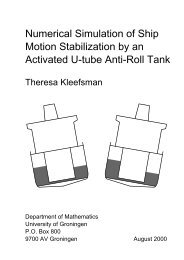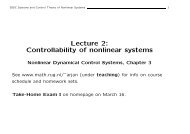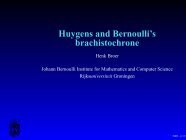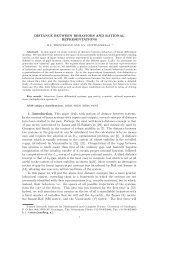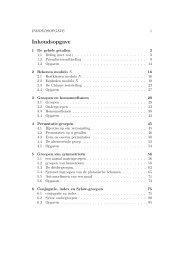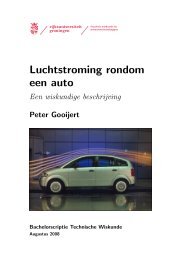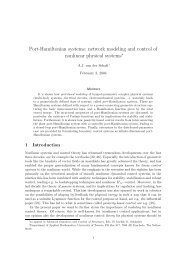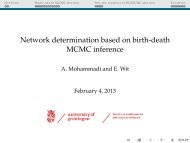Chaos and quasi-periodicity in diffeomorphisms of the solid torus
Chaos and quasi-periodicity in diffeomorphisms of the solid torus
Chaos and quasi-periodicity in diffeomorphisms of the solid torus
You also want an ePaper? Increase the reach of your titles
YUMPU automatically turns print PDFs into web optimized ePapers that Google loves.
Def<strong>in</strong>ition 2. 1. A map M : J → J, where J ⊂ is an <strong>in</strong>terval, is called topologically<br />
mix<strong>in</strong>g if for any open <strong>in</strong>tervals J 1 , J 2 ⊂ J <strong>the</strong>re exists n 0 such that<br />
M n (J 1 ) ∩ J 2 ≠ ∅ for all n ≥ n 0 .<br />
2. The <strong>in</strong>terval K a = [Q 2 a (0), Q a(0)] is called <strong>the</strong> core or <strong>the</strong> restrictive <strong>in</strong>terval <strong>of</strong> <strong>the</strong><br />
Logistic family Q a (13).<br />
It is well-known that Q a ([0, 1]) = Q a (K a ) = K a for all a, where K a is <strong>the</strong> core <strong>of</strong> Q a (13),<br />
see e.g. [24, Section II.5]. For a given <strong>in</strong>teger n > 1, denote by Φ(n) <strong>the</strong> set <strong>of</strong> all <strong>in</strong>tegers q<br />
such that q <strong>and</strong> n are relatively prime, where 1 ≤ q < n. For n = 1 we put Φ(n) = {1}.<br />
Theorem 4. (Hénon-like attractors <strong>in</strong> (4)) Choose a ∗ ∈ (1, 2) such that <strong>the</strong> quadratic<br />
map Q a ∗ <strong>in</strong> (13) is topologically mix<strong>in</strong>g on its core K = [1 − a ∗ , 1] <strong>and</strong> its critical po<strong>in</strong>t c = 0<br />
is preperiodic. Let n ≥ 1 be an <strong>in</strong>teger. There exist a periodic po<strong>in</strong>t p 0 <strong>of</strong> <strong>the</strong> n-th iterate Q n a ∗<br />
<strong>and</strong> positive constants ¯ε n , ā n <strong>and</strong> χ n such that <strong>the</strong> follow<strong>in</strong>g holds.<br />
1. For all (α, δ, a, ε) as <strong>in</strong> (14), with<br />
(α, δ) ∈ ∪ q∈Φ(n) Cl ( A q/n) , |a − a ∗ | < ā n , |ε| < ¯ε n (15)<br />
<strong>the</strong> map T α,δ,a,ε has a saddle periodic po<strong>in</strong>t p, which is <strong>the</strong> analytic cont<strong>in</strong>uation <strong>of</strong> p 0<br />
<strong>and</strong> such that <strong>the</strong> unstable manifold W u (Orb(p)) is one-dimensional.<br />
2. For all (α, δ, ε) as <strong>in</strong> (15) <strong>the</strong>re exists a set S α,δ,ε with<br />
S α,δ,ε ⊂ [a ∗ − ā n , a ∗ + ā n ],<br />
meas(S) > χ n<br />
such that for all a ∈ S α,δ,ε <strong>the</strong> closure Cl (W u (Orb(p))) is a Hénon-like attractor <strong>of</strong><br />
T α,δ,a,ε .<br />
Corollary 5. The set <strong>of</strong> parameter values for which T α,δ,a,ε has a Hénon-like attractor conta<strong>in</strong>s<br />
<strong>the</strong> set<br />
S = ⋃ n∈<br />
{<br />
(α, δ, a, ε) | (α, δ) ∈ ∪q∈Φ(n) Cl ( A q/n) , |ε| < ¯ε n , a ∈ S α,δ,ε<br />
}<br />
,<br />
<strong>and</strong> <strong>the</strong> set S has positive Lebesgue measure<br />
meas(S) ≥ 2<br />
∞∑<br />
¯ε n χ n<br />
n=1<br />
∑<br />
q∈Φ(n)<br />
meas A q/n .<br />
Our pro<strong>of</strong> <strong>of</strong> Theorem 4 is given <strong>in</strong> Section 3.2. It is based on a result <strong>of</strong> Díaz-Rocha-Viana [14,<br />
Theorem 5.2], <strong>and</strong> relies on <strong>the</strong> follow<strong>in</strong>g facts:<br />
1. For (α, δ) <strong>in</strong>side any tongue A q/n , <strong>the</strong> asymptotic dynamics <strong>of</strong> T α,δ,a,ε is described by<br />
an O(ε)-perturbation <strong>of</strong> <strong>the</strong> n-th iterate Q n a .<br />
2. For all n <strong>the</strong> map Q n a is a generic n-modal family, <strong>in</strong> <strong>the</strong> sense <strong>of</strong> [14, Section 5.2],<br />
also see <strong>the</strong> def<strong>in</strong>ition given <strong>in</strong> Section 3.2. To show this, we use that Q a ∗ is a Misiurewicz<br />
map [25], <strong>and</strong>, <strong>the</strong>refore, it is Collet-Eckmann (see e.g. [24, Section V.4]). See<br />
Section 3.2 for details.<br />
12




